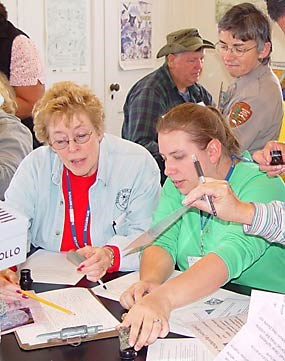
Discovering the answers to two basic questions—primarily, “How do I recognize evidence of geologic change in my environment?” and secondarily, “What is the source of the Crissy Field riprap rocks?”—is the ultimate goal of the field-based Rockin’ in the Riprap experience. In order to achieve this goal, participants use two data sheets, Riprap Rocks—Field Observations and Crissy Field Center Observations and Notes, to record what they see and think. The information sheets, which include photos of various riprap rock types and maps, provide information not accessible at the site. (For more on the decision to use the riprap location, see Planning a Place-based Inquiry Experience for Teachers.)
The essential and secondary questions appear in the upper right-hand corner of each sheet. Recognizing that, similar to school-age students, adults can lose track of an investigation’s main question, we decided to keep the question(s) in front of them throughout. And, because a wealth of information can be gleaned and organized in this field-based experience, participants are asked to write down their observations. The second data sheet suggests questions to prompt the development of explanatory theories in a small-group context prior to discussing the points with the group as a whole.
The Riprap Rocks—Field Observations data sheet is used to record descriptive observations of the half-dozen most important rocks found in the riprap (we do a bit of seeding, which we acknowledge, to ensure that these six rock types are represented). The one-page information sheet, Describing Rocks, illustrates the characteristics geologists use to identify rocks, including grain size, veining, and matrix material. (Students are asked to ignore asphalt and concrete—good recycling, but not relevant to this investigation.) We also carefully select the quadrants each group uses and prompt them when necessary to include particular rocks.
The second data sheet, Crissy Field Center Observations and Notes, guides the participants through four tasks. First, they match their field observations to a set of six labeled rock photographs as well as to samples of these rocks. Second, with names of the riprap rocks in hand, participants review information sheets on each of the rock types: Pillow Basalt, Serpentinite, Radiolarian Chert, Graywacke Sandstone, Granite, and Andecite and Dacite. These information sheets provide more views of the rocks (including maps, if the rocks are not from the Marin or San Francisco headlands), and very brief descriptions (roughly 50 to 75 words) of the conditions under which the rocks were formed. Third, participants examine two maps of the headlands to locate local outcroppings of the four Franciscan Complex rocks. They also examine photographs of Cherts and Pillow Basalts from Pacific Rim locations (Alaska, Japan, Washington state, British Columbia, and Malaysia). Finally, to prompt critical thinking about their observations, they respond to questions on the second data sheet: What is the local source of the riprap rocks? What are their sites of origin? What geologic process could account for their current locations? (Participants with significant geology backgrounds are segregated so they do not give away the answers, thereby spoiling the inquiry experience for the others.)
This segment follows the guidelines for inquiry investigations outlined in Inquiry and the National Science Educations Standards (National Research Council 2000). Participants are engaged in a scientifically oriented question, they give priority to evidence, they formulate explanations based on evidence, and there is a connection to scientific knowledge. These essential features are outlined in an inquiry grid that is reproduced here (the volume is available on-line at http://books.nap.edu/catalog). |
Last updated: July 14, 2021
